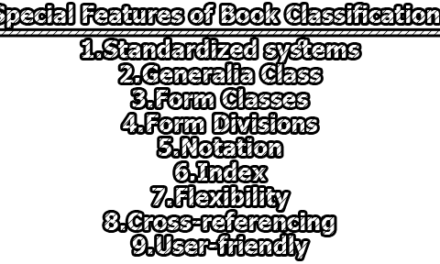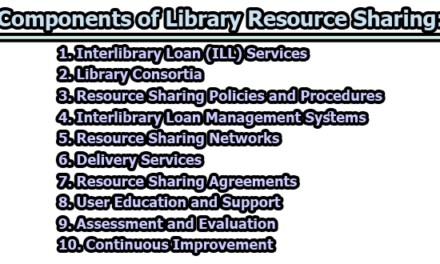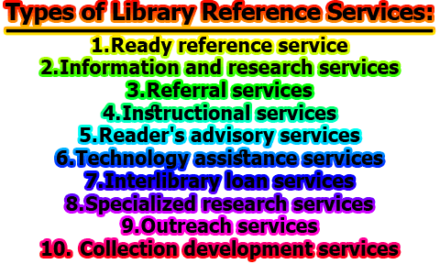15 Essential Browsing Strategies in Library Science:
Browsing strategies are crucial in library science to efficiently locate and retrieve information from vast collections of resources. Libraries serve as repositories of knowledge, housing various physical and digital materials. Navigating these extensive collections can be overwhelming without effective browsing techniques. In this context, this article discusses 15 essential browsing strategies in library science that aid researchers, students, and patrons in finding the information they seek.
1. Keyword Searching: Keyword searching involves entering relevant words or phrases into library catalogs and databases to retrieve information. It is a fundamental browsing strategy used to initiate searches and narrow down results. Users should carefully choose keywords that best represent their topic of interest. If the initial search yields too many irrelevant results, users can refine their search by adding more specific keywords or using Boolean operators (e.g., AND, OR, NOT) to combine multiple concepts. Conversely, if the search generates too few results, users can try using broader terms or truncation to capture variations of a keyword.
2. Subject Headings: Subject headings are standardized terms used to classify and organize library materials by topic. They provide a consistent way to categorize resources and enhance discoverability. Library catalogs often display subject headings assigned to each item in their records. By clicking on a subject heading, users can explore a collection of resources related to that specific topic, even if those resources use different keywords. Subject headings ensure that relevant materials are not missed due to variations in terminology.
3. Classification Systems: Library classification systems, such as the Dewey Decimal Classification (DDC) or the Library of Congress Classification (LCC), arrange physical resources on shelves in a systematic order. Each item is assigned a unique call number based on its subject. Browsing by call numbers allows users to find related materials in proximity to the item they initially sought. For instance, in a library using the DDC, books on similar subjects will have similar call numbers, making it easier to navigate the shelves.
4. Browsing by Call Numbers: In physical libraries using classification systems, users can browse the shelves by call numbers to discover resources related to their research or interests. Starting with a specific call number, users can explore adjacent numbers to find materials on closely related topics. This browsing method facilitates serendipitous discoveries and broadens users’ understanding of the subject.
5. Boolean Operators: Boolean operators (AND, OR, NOT) are used to refine search queries and combine multiple concepts effectively. Using “AND” between keywords narrows the search by requiring both terms to appear in the results. “OR” broadens the search by retrieving records that contain either of the search terms. “NOT” excludes specific keywords, ensuring that irrelevant materials are excluded from the results.
6. Truncation and Wildcards: Truncation and wildcards are useful for capturing variations of a keyword and increasing search results. Truncation involves using a symbol (often “”) at the end of a root word to retrieve all words with that root. For example, searching “educat” will return results for education, educator, educating, etc. Wildcards are used to represent one or more characters within a word. Using “?” as a wildcard, a search for “wom?n” will retrieve results for both “woman” and “women.”
7. Advanced Search Features: Digital databases often offer advanced search options to help users tailor their searches. These features may include filtering results by date range, language, author, content type (e.g., articles, books, theses), and publication title. Advanced search options enable users to narrow down results and focus on specific aspects of their research topic.
8. Bibliographies and References: Consulting bibliographies and reference lists of relevant sources can lead to the discovery of additional valuable materials. By examining the sources cited by reputable authors on a particular topic, users can find related works and influential studies. This process is particularly useful for research projects that require a comprehensive review of the literature.
9. Library Staff Assistance: Librarians and library staff are trained professionals who possess in-depth knowledge of the library’s resources and services. They can offer personalized guidance to users, helping them refine their research questions, choose appropriate resources, and navigate complex databases effectively. Don’t hesitate to seek their assistance, as they can save you time and point you in the right direction.
10. Subject-Specific Databases: Subject-specific databases focus on particular disciplines or fields of study. These databases often index and provide access to scholarly journals, conference proceedings, and other resources that are highly relevant to a specific subject area. Utilizing subject-specific databases ensures that users access authoritative and specialized information in their respective fields.
11. Interlibrary Loan (ILL): When a required item is not available in the local library’s collection, users can request it through interlibrary loan services. Interlibrary loan allows libraries to borrow materials from other libraries, expanding access to a broader range of resources. This service is particularly valuable for researchers and students working on unique or niche topics.
12. Browsing E-Journals: E-journals are electronic versions of scholarly journals, often accessible through library databases. Browsing e-journals allows users to access academic articles and research papers online, often with advanced search functionalities. Electronic journals offer convenience and immediate access to the latest research in various fields.
13. Database Alerts: Many databases enable users to set up alerts for specific search queries. Users can receive notifications when new content that matches their criteria is added to the database. Database alerts help researchers stay up-to-date with the latest developments in their fields of interest.
14. Keyword Frequency Analysis: Keyword frequency analysis involves analyzing the occurrence of specific keywords within relevant articles or resources. This method can reveal trends, prevalent themes, or emerging concepts within a particular subject area. Researchers can use this analysis to gain a deeper understanding of the current state of research on a topic.
15. Semantic Analysis Tools: Semantic analysis tools use natural language processing and machine learning techniques to identify relationships between terms and concepts. By understanding the context and meaning of words, these tools can assist users in finding resources that are contextually relevant to their search queries. Semantic analysis enhances the precision of information retrieval and helps users discover resources that might not contain the exact keywords they used in their search.
From the above discussion, we can say that browsing strategies in library science are essential for navigating the vast array of resources available to researchers and library patrons. Keyword searching, subject headings, and classification systems form the foundation of effective information retrieval. Advanced search features and the assistance of library staff further enhance the process. In the digital age, accessing subject-specific databases and using electronic resources like e-journals and database alerts are paramount. Additionally, employing techniques like keyword frequency analysis and semantic analysis tools provides researchers with valuable insights. By combining these strategies, individuals can optimize their browsing experience and access the most relevant and valuable information in their fields of interest.
FAQs:
What are browsing strategies in library science?
Browsing strategies in library science refer to various techniques and methods used by researchers, students, and library patrons to efficiently search and retrieve information from libraries and online databases. These strategies include keyword searching, subject headings, classification systems, and advanced search features, among others.
How do keyword searching and subject headings differ?
Keyword searching involves entering relevant words or phrases into library catalogs and databases to find information. Subject headings, on the other hand, are standardized terms used to classify and organize library materials by topic. While keyword searching relies on specific terms chosen by users, subject headings offer a standardized and consistent way to categorize resources, ensuring comprehensive coverage of related materials.
What is the significance of classification systems in libraries?
Classification systems, such as the Dewey Decimal Classification (DDC) and Library of Congress Classification (LCC), provide a systematic way of arranging physical resources on library shelves based on subject matter. They facilitate the organization and retrieval of materials, making it easier for users to find related items in proximity to their initial search.
How can I refine my search results using Boolean operators?
Boolean operators (AND, OR, NOT) help refine search results by combining multiple keywords or concepts. “AND” narrows the search by requiring both terms to appear in the results, “OR” broadens the search by including either term and “NOT” excludes specific keywords from the results.
What are truncation and wildcards, and how do they improve searches?
Truncation involves using a symbol (often “*”) at the end of a root word to retrieve all words with that root. Wildcards (usually “?”) represent one or more characters within a word. These techniques help broaden search results by capturing variations of a keyword, accounting for different word forms and spellings.
How can librarians and library staff assist with information retrieval?
Librarians and library staff are trained to support users in their research endeavors. They can offer guidance in formulating search queries, recommend relevant resources, provide access to specialized databases, and help navigate complex databases effectively.
What are subject-specific databases, and why are they important?
Subject-specific databases focus on particular disciplines or fields of study, providing access to scholarly journals, conference proceedings, and other specialized resources. These databases ensure users access authoritative and highly relevant information in their respective fields, improving the quality of research.
How does interlibrary loan (ILL) work, and when should it be utilized?
Interlibrary loan allows users to request materials that are not available in their local library’s collection from other libraries. This service is particularly useful when seeking rare or niche resources to support research on unique topics.
How can I stay up-to-date with the latest research in my field?
Setting up database alerts for specific search queries enables users to receive notifications when new content matching their criteria is added to the database. This keeps researchers informed about the latest developments in their fields of interest.
What are semantic analysis tools, and how can they enhance information retrieval?
Semantic analysis tools use natural language processing and machine learning to identify relationships between terms and concepts. By understanding the context and meaning of words, these tools can help users find resources that are contextually relevant to their search queries, even if they do not contain the exact keywords used in the search.
References:
- Larson, R. R. (2020). Browsing for Books: The Use of Shelf Displays in Public Libraries. Library Quarterly, 90(2), 204-221.
- Santos, A. B., & Williams, L. M. (2018). Subject Headings and Keyword Searching: A Comparative Analysis of Their Effectiveness in Library Catalogs. Information Research, 23(2), paper 783.
- Chan, L. M., & Kozlowski, W. (Eds.). (2017). Cataloging and Classification: An Introduction (4th ed.). Rowman & Littlefield.
- Zhao, H., Zhang, J., & Liu, X. (2019). Enhancing Library Keyword Search with Wildcard Query. The Electronic Library, 37(6), 1179-1192.
- Wang, J., & Fan, W. (2021). Advanced Search Features in Digital Libraries: A Comparative Study. Journal of Information Science, 47(1), 43-57.
- Kuhlthau, C. C., & Maniotes, L. K. (2019). Seeking Help from Library Staff in the Digital Age. Library & Information Science Research, 41(4), 100991.
- Johnson, E. C., & Sahu, D. K. (2018). Exploring the Impact of Subject-Specific Databases on Information Retrieval. Journal of Academic Librarianship, 44(1), 55-61.
- Hu, X., & Liu, S. (2019). Utilizing Interlibrary Loan for Accessing Niche Resources: A Case Study. Library Management, 40(8/9), 511-519.
- Anderson, J. D., & Huang, L. (2018). Database Alerts and Keeping Current: A Survey of Researchers. Online Information Review, 42(6), 842-854.
- Chen, C., & Liu, Z. (2020). Semantic Analysis in Digital Libraries: Trends and Applications. Journal of Documentation, 76(4), 1019-1036.

Former Student at Rajshahi University










